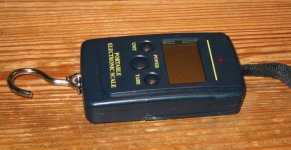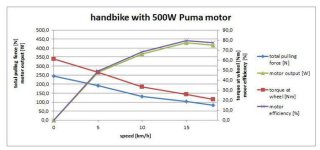handbike_electric
1 mW
- Joined
- May 5, 2016
- Messages
- 12
For our next hand bike project (see https://endless-sphere.com/forums/viewtopic.php?f=2&t=80217&sid=676831c55bbbb422a3042f624c01e0eb) we were wondering about the torque and pulling force, our current handbike can supply.
So I ordered a (pretty cheap) digital baggage scale:

The idea was to take the handbike and to connect it to a regular bike with a rope. The rope ends at the scale, which is connected to the bike trailing behind. The rope needs to be mounted at equal heights above ground on handbike and regular bike. Now the handbike pulls the bike. And the bike controls the speed and measures the pulling "mass".
The scale actually does not measure the mass, but the gravity force created by the mass to weigh. So by taking the measured mass in kg multiplied by 9.81 we get the pulling force in N. Multiplying force with the radius of the wheel is the torque the motor generates. Force multiplied with the speed in m/s is the mechanical output power of the motor. Mechanical output power divided by electrical input power is the motor efficiency in % (I made it easy, assuming that the battery voltage is the typical 36V of the battery and that the current is at the rated limit of the controller of 15A, so electrical power is 36V * 15A = 540W).
If the handbike is moving at constant speed, some force is needed to even keep it running at same speed to overcome friction. This force needs to be added to the pulling force to get real motor parameters. This can be measured by measuring the force needed to pull the handbike at constant speed on a even surface.
Handbike needs to run on max electric motor support possible. Then I used the regular bike to control the speed to the selected values by applying the bikes brakes until reaching and keeping the desired measuring speed (even, solid surface). Then at the same time, the force needs to be read out from the scale. And balance needs to be kept, so be careful!
Excel will do the math, starting with the measured values on the left and the calculated values on the right:

Showing the results in a graph looks like this:

Double checking with http://www.ebikes.ca/tools/simulator.html using the comparable eZee 250rpm motor brings pretty similar values
Final conclusion: For the next handbike we need more torque:
- factor 1.3 due to 26" wheel size compared to the 20" today
- factor 2.5 to have significantly more torque on low speeds for very steep offroad climbing
This will be about 160Nm on the wheel at 5km/h = 40.2rpm = 0.67rps and a mechanical output power of about 673W.
Without going to a gigantic motor, the only solution will be mid motor and a gear ratio putting speed down and torque up.
If you are interested in the hand bike and motor setup, please follow the link above.
So I ordered a (pretty cheap) digital baggage scale:

The idea was to take the handbike and to connect it to a regular bike with a rope. The rope ends at the scale, which is connected to the bike trailing behind. The rope needs to be mounted at equal heights above ground on handbike and regular bike. Now the handbike pulls the bike. And the bike controls the speed and measures the pulling "mass".
The scale actually does not measure the mass, but the gravity force created by the mass to weigh. So by taking the measured mass in kg multiplied by 9.81 we get the pulling force in N. Multiplying force with the radius of the wheel is the torque the motor generates. Force multiplied with the speed in m/s is the mechanical output power of the motor. Mechanical output power divided by electrical input power is the motor efficiency in % (I made it easy, assuming that the battery voltage is the typical 36V of the battery and that the current is at the rated limit of the controller of 15A, so electrical power is 36V * 15A = 540W).
If the handbike is moving at constant speed, some force is needed to even keep it running at same speed to overcome friction. This force needs to be added to the pulling force to get real motor parameters. This can be measured by measuring the force needed to pull the handbike at constant speed on a even surface.
Handbike needs to run on max electric motor support possible. Then I used the regular bike to control the speed to the selected values by applying the bikes brakes until reaching and keeping the desired measuring speed (even, solid surface). Then at the same time, the force needs to be read out from the scale. And balance needs to be kept, so be careful!
Excel will do the math, starting with the measured values on the left and the calculated values on the right:

Showing the results in a graph looks like this:

Double checking with http://www.ebikes.ca/tools/simulator.html using the comparable eZee 250rpm motor brings pretty similar values
Final conclusion: For the next handbike we need more torque:
- factor 1.3 due to 26" wheel size compared to the 20" today
- factor 2.5 to have significantly more torque on low speeds for very steep offroad climbing
This will be about 160Nm on the wheel at 5km/h = 40.2rpm = 0.67rps and a mechanical output power of about 673W.
Without going to a gigantic motor, the only solution will be mid motor and a gear ratio putting speed down and torque up.
If you are interested in the hand bike and motor setup, please follow the link above.

